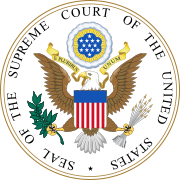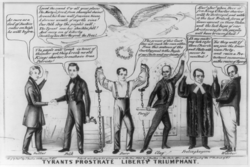| Supreme Court of the United States | |
|---|---|
 | |
| 38°53′26″N 77°00′16″W / 38.89056°N 77.00444°W / 38.89056; -77.00444 | |
| Established | March 4, 1789; 235 years ago (1789-03-04) |
| Location | Washington, D.C. |
| Coordinates | 38°53′26″N 77°00′16″W / 38.89056°N 77.00444°W / 38.89056; -77.00444 |
| Composition method | Presidential nomination with Senate confirmation |
| Authorised by | Constitution of the United States, Art. III, § 1 |
| Judge term length | Life tenure, subject to impeachment and removal |
| Number of positions | 9 (by statute) |
| Website | supremecourt |
| This article is part of a series on the |
| Supreme Court of the United States |
|---|
 |
| The Court |
| Current membership |
|
| Lists of justices |
|
| Court functionaries |
This is a list of cases reported in volume 48 (7 How.) of United States Reports, decided by the Supreme Court of the United States in 1848 and 1849.
Nominative reports
In 1874, the U.S. government created the United States Reports, and retroactively numbered older privately-published case reports as part of the new series. As a result, cases appearing in volumes 1–90 of U.S. Reports have dual citation forms; one for the volume number of U.S. Reports, and one for the volume number of the reports named for the relevant reporter of decisions (these are called "nominative reports").
Benjamin Chew Howard
Starting with the 42nd volume of U.S. Reports, the Reporter of Decisions of the Supreme Court of the United States was Benjamin Chew Howard. Howard was Reporter of Decisions from 1843 to 1860, covering volumes 42 through 65 of United States Reports which correspond to volumes 1 through 24 of his Howard's Reports. As such, the dual form of citation to, for example, United States v. City of Chicago is 48 U.S. (7 How.) 185 (1849).
Justices of the Supreme Court at the time of 48 U.S. (7 How.)
See also: List of justices of the Supreme Court of the United States See also: List of United States Supreme Court justices by time in office See also: List of justices of the Supreme Court of the United States by court compositionThe Supreme Court is established by Article III, Section 1 of the Constitution of the United States, which says: "The judicial Power of the United States, shall be vested in one supreme Court . . .". The size of the Court is not specified; the Constitution leaves it to Congress to set the number of justices. Under the Judiciary Act of 1789 Congress originally fixed the number of justices at six (one chief justice and five associate justices). Since 1789 Congress has varied the size of the Court from six to seven, nine, ten, and back to nine justices (always including one chief justice).
When the cases in 48 U.S. (7 How.) were decided the Court comprised these nine members:
| Portrait | Justice | Office | Home State | Succeeded | Date confirmed by the Senate (Vote) |
Tenure on Supreme Court |
|---|---|---|---|---|---|---|
 |
Roger B. Taney | Chief Justice | Maryland | John Marshall | March 15, 1836 (29–15) |
March 28, 1836 – October 12, 1864 (Died) |
 |
John McLean | Associate Justice | Ohio | Robert Trimble | March 7, 1829 (Acclamation) |
January 11, 1830 – April 4, 1861 (Died) |
 |
James Moore Wayne | Associate Justice | Georgia | William Johnson | January 9, 1835 (Acclamation) |
January 14, 1835 – July 5, 1867 (Died) |
 |
John Catron | Associate Justice | Tennessee | newly created seat | March 8, 1837 (28–15) |
May 1, 1837 – May 30, 1865 (Died) |
 |
John McKinley | Associate Justice | Alabama | newly created seat | September 25, 1837 (Acclamation) |
January 9, 1838 – July 19, 1852 (Died) |
 |
Peter Vivian Daniel | Associate Justice | Virginia | Philip P. Barbour | March 2, 1841 (25–5) |
January 10, 1842 – May 31, 1860 (Died) |
 |
Samuel Nelson | Associate Justice | New York | Smith Thompson | February 14, 1845 (Acclamation) |
February 27, 1845 – November 28, 1872 (Retired) |
 |
Levi Woodbury | Associate Justice | New Hampshire | Joseph Story | January 31, 1846 (Acclamation) |
September 23, 1845 – September 4, 1851 (Died) |
 |
Robert Cooper Grier | Associate Justice | Pennsylvania | Henry Baldwin | August 4, 1846 (Acclamation) |
August 10, 1846 – January 31, 1870 (Retired) |
Notable cases in 48 U.S. (7 How.)

Luther v. Borden
In Luther v. Borden, 48 U.S. (7 How.) 1 (1849), the Supreme Court established the political question doctrine in controversies arising under the Guarantee Clause of Article Four of the United States Constitution (Art. IV, § 4). The holding that the "republican form of government" clause of Article Four is non-justiciable still stands today. The case arose from the Dorr Rebellion in Rhode Island.
Passenger Cases
Smith v. Turner, and Norris v. Boston, 48 U.S. (7 How.) 283 (1849), are two similar cases, argued together before the Supreme Court, which decided 5-4 that states do not have the right to impose a tax determined by the number of passengers of a designated category on board a ship and/or disembarking into the State. Together, the cases are sometimes termed the Passenger Cases. The Court did not produce a majority opinion. Eight Justices authored separate opinions, totalling hundreds of pages, and their respective stances on various issues did not always align with other justices in their concurrences or dissents. The Passengers Cases are of historical interest. They portray diverse views on several constitutional questions, especially whether the Commerce Clause prohibits any state regulation of interstate and foreign commerce in the absence of federal law or treaty. The failure of the Court to produce a majority opinion significantly diminished the value of the Passengers Cases as a precedent.
Citation style
See also: United States district court See also: United States circuit court See also: United States federal courtsUnder the Judiciary Act of 1789 the federal court structure at the time comprised District Courts, which had general trial jurisdiction; Circuit Courts, which had mixed trial and appellate (from the US District Courts) jurisdiction; and the United States Supreme Court, which had appellate jurisdiction over the federal District and Circuit courts—and for certain issues over state courts. The Supreme Court also had limited original jurisdiction (i.e., in which cases could be filed directly with the Supreme Court without first having been heard by a lower federal or state court). There were one or more federal District Courts and/or Circuit Courts in each state, territory, or other geographical region.
Bluebook citation style is used for case names, citations, and jurisdictions.
- "C.C.D." = United States Circuit Court for the District of . . .
- e.g.,"C.C.D.N.J." = United States Circuit Court for the District of New Jersey
- "D." = United States District Court for the District of . . .
- e.g.,"D. Mass." = United States District Court for the District of Massachusetts
- "E." = Eastern; "M." = Middle; "N." = Northern; "S." = Southern; "W." = Western
- e.g.,"C.C.S.D.N.Y." = United States Circuit Court for the Southern District of New York
- e.g.,"M.D. Ala." = United States District Court for the Middle District of Alabama
- "Ct. Cl." = United States Court of Claims
- The abbreviation of a state's name alone indicates the highest appellate court in that state's judiciary at the time.
- e.g.,"Pa." = Supreme Court of Pennsylvania
- e.g.,"Me." = Supreme Judicial Court of Maine
List of cases in 48 U.S. (7 How.)
See also: Taney CourtNotes and references
- Anne Ashmore, DATES OF SUPREME COURT DECISIONS AND ARGUMENTS, Library, Supreme Court of the United States, 26 December 2018.
- "Supreme Court Research Guide". Georgetown Law Library. Retrieved April 7, 2021.
See also
External links
- Case reports in volume 48 (7 How.) from Library of Congress
- Case reports in volume 48 (7 How.) from Court Listener
- Case reports in volume 48 (7 How.) from the Caselaw Access Project of Harvard Law School
- Case reports in volume 48 (7 How.) from Google Scholar
- Case reports in volume 48 (7 How.) from Justia
- Case reports in volume 48 (7 How.) from Open Jurist
- Website of the United States Supreme Court
- United States Courts website about the Supreme Court
- National Archives, Records of the Supreme Court of the United States
- American Bar Association, How Does the Supreme Court Work?
- The Supreme Court Historical Society
| Lists of United States Supreme Court cases | ||
|---|---|---|
| List of cases by Court |
|  |
| Complete list | List of cases by volume (United States Reports) | |
| By recent term | ||
| By subject matter | ||
| Other lists | ||
